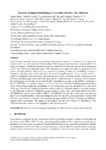Mostrar o rexistro simple do ítem
Reactive transport modelling of a low-pH concrete / clay interface
| dc.contributor.author | Idiart, Andrés | |
| dc.contributor.author | Laviña, Marcelo | |
| dc.contributor.author | Kosakowski, Georg | |
| dc.contributor.author | Cochepin, Benoit | |
| dc.contributor.author | Meeussen, Johannes C.L. | |
| dc.contributor.author | Samper, Javier | |
| dc.contributor.author | Mon, Alba | |
| dc.contributor.author | Montoya, Vanessa | |
| dc.contributor.author | Munier, Isabelle | |
| dc.contributor.author | Poonoosamy, Jenna | |
| dc.contributor.author | Montenegro, Luis | |
| dc.contributor.author | Deissmann, Guido | |
| dc.contributor.author | Rohmen, Stephan | |
| dc.contributor.author | Damiani, Leonardo Hax | |
| dc.contributor.author | Coene, Emilie | |
| dc.contributor.author | Naves, Acacia | |
| dc.date.accessioned | 2024-01-30T17:31:34Z | |
| dc.date.available | 2024-01-30T17:31:34Z | |
| dc.date.issued | 2020 | |
| dc.identifier.citation | Idiart, A., Laviña, M., Kosakowski, G., Cochepin, B., Meeussen, J. C., Samper, J., ... & Naves, A. (2020). Reactive transport modelling of a low-pH concrete/clay interface. Applied geochemistry, 115, 104562. https://doi.org/10.1016/j.apgeochem.2020.104562 | es_ES |
| dc.identifier.uri | http://hdl.handle.net/2183/35247 | |
| dc.description | Versión aceptada de https://doi.org/10.1016/j.apgeochem.2020.104562 | es_ES |
| dc.description.abstract | [Abstract:] Cement-based materials are key components in the barrier system and structural support of repositories for disposal of nuclear waste. As such, increased understanding of their long-term performance under repository conditions is paramount for the safety assessment. Quantification of the impact that cement-based materials could have on the surrounding barriers and the host rock is essential to assess long-term safety of the repository system. This interaction can impact the physical properties of the system near the interface and needs to be assessed by means of numerical modelling. A reactive transport modelling study of the interaction between a newly-developed low-pH concrete and a clay host rock (i.e. Callovo Oxfordian) over 100,000 years is presented here. The main goal is to build confidence in the consistency of the different modelling approaches and in the application of different reactive transport codes (iCP, ORCHESTRA, OpenGeosys-GEM, CORE2D, and MIN3P) to analyse the performance of the recently developed low-pH concrete within the CEBAMA project. A common setup of a reference case was established, including precipitation/dissolution reactions, redox and cation exchange processes, building upon preliminary cases of increasing complexity. In addition, a set of sensitivity cases was simulated to test the effect of key geochemical and transport parameters on the results, including the impact of porosity changes on the diffusion coefficient and electrochemical couplings. Different reactive transport codes were used in the benchmark. Overall, the results show not only the high level of understanding of the governing processes but also the good agreement obtained with different codes, which is essential to demonstrate the applicability of reactive transport modelling to support safety assessment. The sensitivity and preliminary cases modelled show that the results obtained are much more sensitive to changes to transport parameters and couplings than to the different modelling tools used in each case. In addition, the impact of including or not the slow kinetics of dissolution of the claystone minerals is shown to be negligible in the studied scenarios. | es_ES |
| dc.description.sponsorship | The research leading to these results has received funding from the European Union's European Atomic Energy Community's Horizon 2020 Programme (NFRP-2014/2015) under grant agreement, 662147 – CEBAMA. V. Montoya., J. Poonoosamy and G. Deissmann acknowledge the German Federal Ministry of Education and Research (Grant 02NUK053A) and the Initiative and Networking Fund of the Helmholtz Association (Grant SO-093) within the iCross project for partial funding. The authors would like to thank Barbara Lothenbach for fruitful discussions on modelling cement hydration of the low-pH cement system and the two reviewers for constructive and valuable comments that have helped to improve the manuscript. | es_ES |
| dc.description.sponsorship | Alemania. German Federal Ministry of Education and Research; 02NUK053A | es_ES |
| dc.description.sponsorship | Alemania. Initiative and Networking Fund of the Helmholtz Association; SO-093 | es_ES |
| dc.language.iso | eng | es_ES |
| dc.publisher | Elsevier | es_ES |
| dc.relation | info:eu-repo/grantAgreement/EC/H2020/662147 | es_ES |
| dc.relation.uri | https://doi.org/10.1016/j.apgeochem.2020.104562 | es_ES |
| dc.rights | Atribución-NoComercial-SinDerivadas 3.0 España | es_ES |
| dc.rights.uri | http://creativecommons.org/licenses/by-nc-nd/3.0/es/ | * |
| dc.subject | Benchmark | es_ES |
| dc.subject | Reactive transport modelling | es_ES |
| dc.subject | Low-pH concrete | es_ES |
| dc.subject | Cement-clay interaction | es_ES |
| dc.title | Reactive transport modelling of a low-pH concrete / clay interface | es_ES |
| dc.type | info:eu-repo/semantics/article | es_ES |
| dc.rights.access | info:eu-repo/semantics/openAccess | es_ES |
| UDC.journalTitle | Applied Geochemistry | es_ES |
| UDC.volume | 115 | es_ES |
| UDC.startPage | 104562 | es_ES |
| dc.identifier.doi | 10.1016/j.apgeochem.2020.104562 |
Ficheiros no ítem
Este ítem aparece na(s) seguinte(s) colección(s)
-
GI- AQUATERRA - Artigos [50]
-
OpenAIRE [324]






